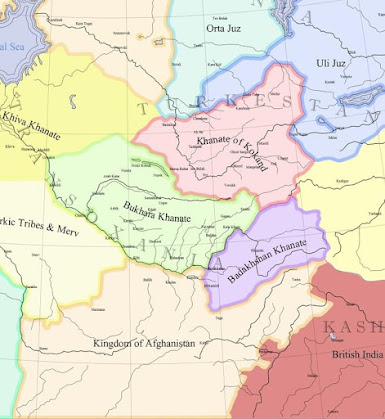In the 17th and 18th centuries, the Khanate was ruled by the Janid Dynasty (Astrakhanids or Toqay Timurids). They were the last Genghisid descendants to rule Bukhara.
By 1510 the Uzbeks had completed their conquest of Central Asia, including the territory of the present-day Uzbekistan. From 1533 to 1540, Bukhara briefly became its capital during the reign of Ubaydallah Khan. The Khanate reached its greatest extent and influence under its penultimate Shaybanid ruler, the scholarly Abdallah Khan II. When Abdallah II died in 1598, his son and successor Abdalmumin, who had spent a number of years as governor of Balkh, managed to stay on the throne only a few months before he was ousted and killed in the disorders that followed his father's death.
In 1556. Jani Muhammad (brother-in-law of Abdallah) married the Uzbek khan's sister, and he acceded to the vacated throne in Bukhara as the first ruler of a dynasty called Janid or Ashtarkhanid; descendants of another line of the Jochids, not through Shiban but through Tuqay Timur, one of Juchi's other sons. although some territory was lost, the political stability and economic well-being of the state were not immediately affected.
The khans of Ḵīva, beginning with Abuʾl-Ḡāzī (1644-64), took advantage of Janid difficulties and repeatedly raided Transoxiana, often penetrating to its central regions.
The Janid dynasty, ruled Transoxania after 1599. Under their rule the city and khanate crystallized into an almost classical pattern of a Muslim polity of its time, cherishing and even enhancing traditional values. The Janid dynasty is considered to have had a strong Muslim influence and promoted the construction of a large number of mosques and madrasas.
From the elevated political and cultural accomplishments of the Shaybānids, the level and extent of Uzbek influence slid into decline under Ashtarkhanid rule, reaching a low point by the mid-1700s. In 1740, it was conquered by Nader Shah, the Shah of Iran.
Janid Dynasty
Saturday, January 29, 2022
The top most popular articles
-
Modern Macedonia was a part of the ancient Empire of Macedonia, which partly covered territory now in southwestern Bulgaria and northern Gre...
-
The Zagwe dynasty (c. 1137–1270 AD) represents a transformative chapter in Ethiopian history, bridging the decline of the Aksumite Empire an...
-
The most prominent and earliest seats of Western civilization first appeared on the island of Crete about 2600 BC. The people in Crete depen...
-
They were a group of Arabian tribes who settled in Northern Arabia and the southern parts of the Levant during the fifth-fourth centuries BC...
-
The Harappan or Indus Valley Civilization, which thrived between approximately 3300 and 1300 BCE, stands as one of the world’s earliest and ...






